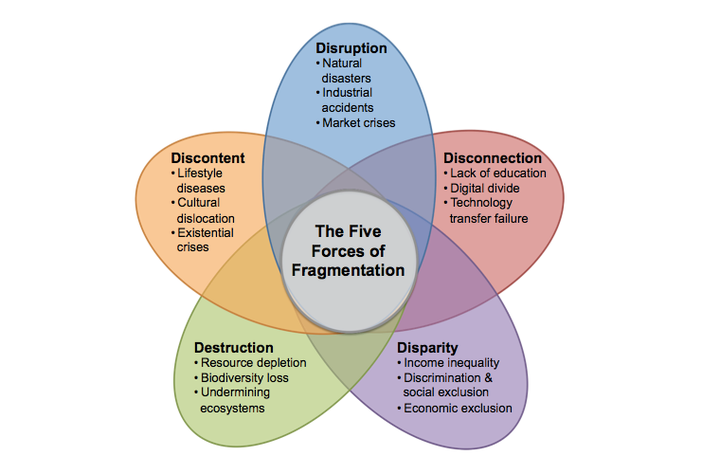
How do we know when value to society is being destroyed by economic activities? Taking a systems science perspective, the answer is: whenever it causes fragmentation, or disintegration. This is consistent with the idea that the tendency towards greater integration in nature and society is a fundamental principle of evolution (Smuts, 2013; Capra, 2014).
Hence, fragmentation is by definition devolutionary, literally causing disintegration or the destruction of complexity. Complexity in this instance does not refer to ‘complicatedness’, but rather to synergistic connection or positively reinforcing relationships, in the same way in which our brains embody complexity through its 100 billion interconnected neurons. My contention is that this disintegration in society occurs in at least five principle ways, which I call the five forces of fragmentation: disruption, disconnection, disparity, destruction and disease.
The Five Forces of Fragmentation
An emphasis on integrated value may seem obvious or even inevitable to some. After all, following decades (some would even say centuries) of globalisation and the acceleration of international trade and tele-digital connectivity, the world seems more integrated than ever before (The Economist, 2013). But the globalisation trend has also masked cracks in the façade of integration, beyond the recent political trend of rising nationalism and protectionism in the Trump era (Plender, 2017).
As systems scientists remind us, any complex system exists in a state of dynamic equilibrium, which, if sufficiently disrupted will either break through to a higher state of integration, or break down into a lower state of fragmentation (Laszlo, 2014). In our world today, we feel the tension between the tendency towards integration and the counter-tendency towards disintegration. For example, if we look at the data on security risks, digital distribution, social inequality, ecological integrity and human wellbeing, we can see that there are powerful forces of disintegration that threaten global harmony and progress for all. These can be distilled into the following five forces of fragmentation in what I call the Fracture Economy.

Disruption – This refers to any instability that threatens human life, safety and security, and is most often associated with political conflicts, acts of terrorism, demographic disruption, industrial accidents and natural disasters. For instance, according to the Global Peace Index 2016, only 10 countries in the world can be classified as conflict free (Institute for Economics and Peace, 2016). Another example is the 65.3 million forcibly displaced people worldwide, including 21.3 million refugees and 10 million stateless people (UNHCR, 2017).
Disconnection – This refers to any form of isolation that prevents human communication and effective data sharing, and is most often associated with a lack of access to knowledge, uncensored media and information technology. For instance, 4 billion people still lack access to the internet and nearly 6 billion people do not have high-speed internet (World Bank, 2016). And nearly 2 billion do not use a mobile phone, and almost half a billion live outside areas with a mobile signal (World Bank, 2016).
Disparity – This refers to any inequities that increase social friction or inefficient resource utilisation, and is most often associated with income inequality, over-consumption and unnecessary private asset ownership. For instance, since 2015 the richest 1% has owned more wealth than the rest of the world’s population and 8 men now own the same amount of wealth as the poorest 50% (Oxfam, 2017). And from 1960 to today, the absolute gap between the average incomes of people in the richest and poorest countries has grown by 135% (Bolt and van Zanden, 2014).
Destruction – This refers to any production and consumption that leads to the decline of resources and disruption of ecosystems, and is most often associated with rapacious economic growth, demographic changes and industrial pollution. For instance, according to the Living Planet Index, populations of vertebrate species declined 58% between 1970 and 2012 and will decline 67% by 2020 if current trends continue (WWF, 2016). And unabated climate change, resulting in 2.5 degrees Celsius warming, will devastate ecosystems, increase poverty and cost the global economy $12 trillion by 2050 (UNDP, 2016).
Discontent – This refers to all unhealthy lifestyles and toxic environments that impair human wellbeing, and is most often associated with stressful workplaces, poor diets, lack of exercise and negative psychological attitudes. For instance, more than 40% of deaths from non-communicable diseases (which account for 70% of all deaths, an increase since 2000) are premature or preventable, notably from cardiovascular and respiratory diseases, cancers and diabetes (WHO, 2017). And depression and anxiety disorders affect 10% of people, cost the global economy US$1 trillion each year and have increased 50% from 1990 and 2013 (WHO and World Bank, 2016).
Countering the Forces of Fragmentation
How might this this value destruction in society be countered or reversed? There are clues in innovations that are occurring in five emerging economic spheres: the resilience, digital, access, circular and wellbeing economies. In each of these areas, there are breakthrough business models, practices, products and services that are building, rather than destroying, societal value. I call these the five pathways to innovation, defined in terms of the desired future state they are trying to advance, which is a society that is more: safe, smart, shared, sustainable and satisfying.
Hence, one of the decisive factors that may tip the balance between these opposing evolutionary forces in society – in favour of integration rather than disintegration – is synergistic innovation. Table 1 summarises these tension and potentials.

There is ample case-study evidence that the five pathways to innovation are creating value beyond narrow financial or economic conceptions. Viewed in terms of a multi-capital perspective, we can demonstrate that they are building – in addition to financial capital – infrastructural, technological, human, social and ecological capital. However, the real breakthrough in value creation comes when two or more of the pathways to innovation are synergistically combined, thus creating integrated value. Let me define the concept fully:
Integrated Value is the simultaneous building of multiple capitals (notably financial, infrastructural, technological, human, social and ecological) through synergistic innovation across the resilience, digital, access, circular and wellbeing economies that result in a world that is more safe, smart, shared, sustainable and satisfying.
You can read more about the Five Forces of Integration and the Pathways to Innovation in my HuffPost article, Synergy: The Driver of Integrated Value in the New Nexus Economy
References
Bolt, J. & Van Zanden, J. L. (2014). The Maddison Project: collaborative research on historical national accounts. The Economic History Review, 67 (3): 627–651.
Capra, F. (2014). The Systems View of Life: A Unifying Vision. Cambridge, UK: Cambridge University Press.
Institute for Economics and Peace. (2016). Global Peace Index 2016. Sydney.
Laszlo, E. (2014). The Chaos Point: The World at the Crossroads. London: Hachette UK.
Oxfam. (2017). An economy for the 99%. Oxfam Briefing Paper, January.
Plender, J. (2017). Trump blind to the global cost of protectionism. Financial Times, January 31.
Smuts, J. (2013). Holism and Evolution. Gouldsboro, ME: Gestalt Journal Press.
The Economist. (2013). When did globalisation start? September 23.
UNDP. (2016). Pursuing the 1.5°C Limit: Benefits and Opportunities. New York.
WHO. (2017). Noncommunicable diseases factsheet. Geneva, April.
WHO & World Bank. (2016). Investing in treatment for depression and anxiety leads to fourfold return. Washington, DC, 13 April.
World Bank. (2016). World Development Report 2016: Digital Dividends. Washington, DC.
WWF. (2016). Living Planet Report 2016: Risk and Resilience in a New Era. Geneva.
